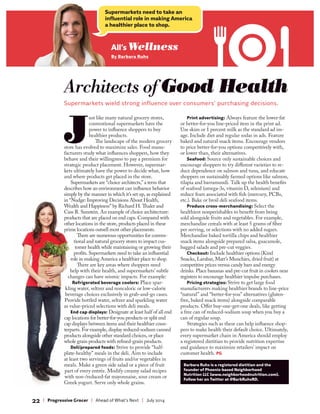Supermarkets: Architects of Good Health
- 1. 22 | Progressive Grocer | Ahead of WhatŌĆÖs Next | July 2014 J ust like many natural grocery stores, conventional supermarkets have the power to influence shoppers to buy healthier products. The landscape of the modern grocery store has evolved to maximize sales. Food manu- facturers study what influences shoppers, how they behave and their willingness to pay a premium for strategic product placement. However, supermar- kets ultimately have the power to decide what, how and where products get placed in the store. Supermarkets are ŌĆ£choice architects,ŌĆØ a term that describes how an environment can influence behavior simply by the manner in which itŌĆÖs set up, as explained in ŌĆ£Nudge: Improving Decisions About Health, Wealth and HappinessŌĆØ by Richard H. Thaler and Cass R. Sunstein. An example of choice architecture: products that are placed on end caps. Compared with other locations in the store, products placed in these prime locations outsell most other placements. There are numerous opportunities for conven- tional and natural grocery stores to impact cus- tomer health while maintaining or growing their profits. Supermarkets need to take an influential role in making America a healthier place to shop. There are key areas where shoppers need help with their health, and supermarketsŌĆÖ subtle changes can have seismic impacts. For example: Refrigerated beverage coolers: Place spar- kling water, seltzer and noncaloric or low-calorie beverage choices exclusively in grab-and-go cases. Provide bottled water, seltzer and sparkling water as value-priced selections with deli meals. End cap displays: Designate at least half of all end cap locations for better-for-you products or split end cap displays between items and their healthier coun- terparts. For example, display reduced-sodium canned products alongside other standard choices, or place whole grain products with refined-grain products. Deli/prepared foods: Strive to provide ŌĆ£half- plate-healthyŌĆØ meals in the deli. Aim to include at least two servings of fruits and/or vegetables in meals. Make a green side salad or a piece of fruit part of every entr├®e. Modify creamy salad recipes with non-/reduced-fat mayonnaise, sour cream or Greek yogurt. Serve only whole grains. Print advertising: Always feature the lower-fat or better-for-you line-priced item in the print ad. Use skim or 1 percent milk as the standard ad im- age. Include diet and regular sodas in ads. Feature baked and natural snack items. Encourage vendors to price better-for-you options competitively with, or lower than, their alternatives. Seafood: Source only sustainable choices and encourage shoppers to try different varieties to re- duce dependence on salmon and tuna, and educate shoppers on sustainably farmed options like salmon, tilapia and barramundi. Talk up the health benefits of seafood (omega-3s, vitamin D, selenium) and reduce fears associated with fish (mercury, PCBs, etc.). Bake or broil deli seafood items. Produce cross-merchandising: Select the healthiest nonperishables to benefit from being sold alongside fruits and vegetables. For example, merchandise cereals with at least 5 grams of fiber per serving, or selections with no added sugars. Merchandise baked tortilla chips and healthier snack items alongside prepared salsa, guacamole, bagged salads and pre-cut veggies. Checkout: Include healthier options (Kind Snacks, Larabar, MattŌĆÖs Munchies, dried fruit) at competitive prices versus candy bars and energy drinks. Place bananas and pre-cut fruit in coolers near registers to encourage healthier impulse purchases. Pricing strategies: Strive to get large food manufacturers making healthier brands to line-price ŌĆ£naturalŌĆØ and ŌĆ£better-for-youŌĆØ alternatives (gluten- free, baked snack items) alongside comparable products. Offer buy-one-get-one deals, like getting a free can of reduced-sodium soup when you buy a can of regular soup. Strategies such as these can help influence shop- pers to make health their default choice. Ultimately, every supermarket chain in America should employ a registered dietitian to provide nutrition expertise and guidance to maximize retailersŌĆÖ impact on customer health. PG Architects of Good Health Supermarkets wield strong influence over consumersŌĆÖ purchasing decisions. AllŌĆÖs Wellness By Barbara Ruhs Barbara Ruhs is a registered dietitian and the founder of Phoenix-based Neighborhood Nutrition LLC (www.neighborhoodnutrition.com). Follow her on Twitter at @BarbRuhsRD. Supermarkets need to take an influential role in making America a healthier place to shop.

